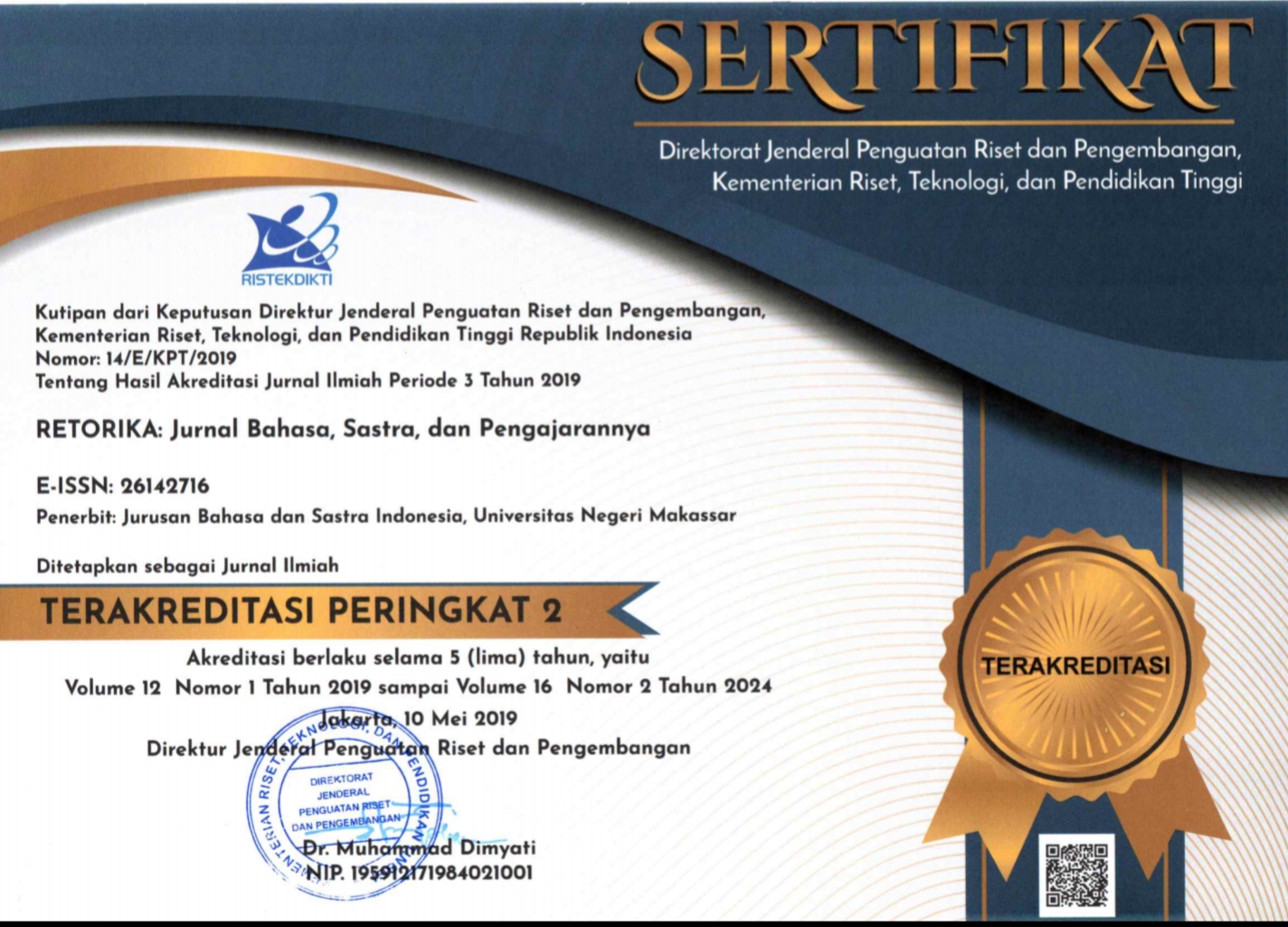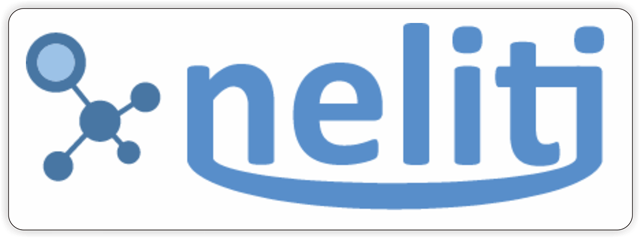MULTILITERACY LEARNING MODEL THROUGH SYNERGY BETWEEN THE NEEDS OF THE WORKPLACE AND LEARNING LANGUAGE SKILLS COURSES
(1) UIN Fatmawati Soekarno Bengkulu
(2) UIN Fatmawati Soekarno Bengkulu
(*) Corresponding Author
DOI: https://doi.org/10.26858/retorika.v16i2.24177
Abstract
Keywords
Full Text:
PDFReferences
Alper, Meryl. (2013). Developmentally Appropriate New Media Literacies: Supporting Cultural Competencies and Social Skills in Early Childhood Education. Journal of Early Childhood Literacy. Volume: 13 issue: 2, page(s): 175-196 June 1, 2013. https://journals.sagepub.com/doi/full/10.1177/1468798411430101.
Amgott, Natalie. (2023). The Challenge was fun”: Critical Literacy and Growth Mindset in L2 Multiliteracies. System. Volume 113, 2023, 103000, https://doi.org/10.1016/j.system.2023.103000.https://www.sciencedirect.com/science/article/pii/S0346251X23000222.
Arends, R. (2008). Learning To Teach:Belajar untuk Mengajar. Yogyakarta: Pustaka Belajar.
Barron, Nancy G. (2007). Book Review: Multiliteracies: Literacy: Learning and the Design of Social Futures. Technical Communication Quarterly, Autumn, 16, 4.
Borg, Walter R. & Gall, Meredith D. (1983). Educational Research.An introduction (4th ed.). New York: Longman Inc.
Carel, G., Sugiarni, R., Algifari, E., & Yastrib, H. (2018). Implementasi Pilar-Pilar Budaya Cianjur dalam Pembelajaran Multiliterasi Matematis Berbantuan Teknologi Smartphone (Geogebra Versi Android) ntuk Meningkatkan Kemampuan Higher Order Thinking Skill (Hots) Siswa Sekolah Kejuruan. In Prisma (Vol. 70, Issue 1). Https://Jurnal.Unsur.Ac.Id/Prisma.
Cooper, N., Lockyer, L., & Brown, I. (2013). Developing Multiliteracies In A Technology-Mediated Environment.
Cooper., Natalie; Lockyer, Lori; Brown, Ian. (2013). Developing Multiliteracies in a Technology-Mediated Environment. Educational Media International. v50 n2 p93-107 https://eric.ed.gov/?q=multiliteracy+learning&id=EJ1005258.
Dahar, R.W. (1989). Teori-TeoriBelajar. Erlangga. Jakarta.
Dawson, S., & Siemens, G. (2014). Analytics to Literacies: The Development of a Learning Analytics Framework for Multiliteracies Sssessment”. The International Review of Research in Open and Distributed Learning. 15(4). https://doi.org/10.19173/irrodl.v15i4.1878.
Hesterman, Sandra. (2011). A Contested Space: The Dialogic Intersection of ICT, Multiliteracies, and Early Childhood”. Contemporary Issues in Early Childhood. v12 n4 p349-361. https://eric.ed.gov/?q=multiliteracy+learning&id=EJ954665.
Hesterman, Sandra. (2017).Time Flies in California": Multiliteracies Bridging Local Diversity and Global Connectedness Through a "Reggio"-Inspired Approach. Pedagogy, Culture and Society. v25 n3 p357-373 2017. https://eric.ed.gov/?q=multiliteracy+learning&id=EJ1153524.
Ibda, H .(2017).Urgensi Pemertahanan Bahasa Ibu di Sekolah Dasar. Jurnal SHAHIH. Vol 2, Nomor 2, Juli - Desember.
Kalantzis M., Cope B. (2008). Language Education and Multiliteracies”. In: Hornberger N.H. (eds) Encyclopedia of Language and Education. Springer: Boston, MA.
Kim, Mi Song. (2016). Uncovering One Trilingual Child's Multi-Literacies Development across Informal and Formal Learning Contexts. European Early Childhood Education Research Journal. V.24 No.3 P. 414-438. https://eric.ed.gov/?q=multiliteracy+learning&id=EJ1098890.
Morocco, C.C, et al. (2008). Supported Literacy for Adolescents: Transforming Teaching and Content Learning for the Twenty-First Century. San Fransisco: Jossey-Bass a Wiley Imprint. http://bhairawaputera.multiply.com. Diakses 15 Desember 2016.
New London Group. 1996. A Pedagogy of Multiliteracies: Designing Social Futures. Harvard Educational Review, 66.
Rowsell, J. dan Walsh, D. (2011). Rethinking Literacy Education In New Times: Multimodality, Multiliteracies, & New Literacies. Brock Education: a Journal Of Educational Research And Practice. Vol 21, No.1. https://journals.library.brocku.ca/brocked/index.php/home/issue/view/23.
Santori, Diane dan Smith, Carol A. (2018). Teaching and Learning with iPads to Support Dialogic Construction of Multiliteracies. Middle School Journal. v49 n1 p24-31. https://eric.ed.gov/?q=multiliteracy+learning&id=EJ1165274.
Suyanto, Slamet. (2019). PengembanganKompetensi Guru Menghadapi Era RevolusiIndustri 4.01. Makalah. Disampaikan pada Seminar Nasional Pendidikan Biologi&Saintek (SNPBS) Ke-IV Pendidikan Biologi FKIP UMS Surakarta, 27 April 2019.
Takeuchi, Miwa. 2015. “The Situated Multiliteracies Approach to Classroom Participation: English Language Learners' Participation in Classroom Mathematics Practices”. Journal of Language, Identity, and Education. v14 n3 p159-178 https://eric.ed.gov/?q=multiliteracy+learning&id=EJ1069098.
Tsimpli, Ianthi. (2019). “Multilingualism and Multiliteracy in Primary Education in India: A Discussion of Some Methodological Challenges of an Interdisciplinary Research Project”. Research in Comparative and International Education. v14 n1 p54-76. https://eric.ed.gov/?q=multiliteracy+learning&id=EJ1209657.
Zhang, Zheng; Nagle, Joelle; McKishnie, Bethany; Lin, Zhen; Li, Wanjing. (2019). “Scientific Strengths and Reported Effectiveness: A Systematic Review of Multiliteracies Studies”. Pedagogies: An International Journal. v14 n1 p33-61. https://eric.ed.gov/?id=EJ1205745.
Article Metrics
Abstract view : 241 times | PDF view : 81 timesRefbacks
- There are currently no refbacks.
Copyright (c) 2023 Ixsir Eliya

This work is licensed under a Creative Commons Attribution-NonCommercial 4.0 International License.
Published by:
Department of Indonesian Language, Faculty of Languages and Literature, Universitas Negeri Makassar in cooperate with Asosiasi Dosen Bahasa dan Sastra Indonesia (ADOBSI) and Ikatan Program Studi Pendidikan Bahasa dan Sastra Indonesia (IKAPROBSI).
Address: Department of Indonesian Language Office, DG Building Second Floor, UNM Parangtambung, Daeng Tata Raya Street, Makassar, South Sulawesi, Indonesia
 Email: retorika@unm.ac.id
Email: retorika@unm.ac.id

RETORIKA: Jurnal Bahasa, Sastra,dan Pengajarannya is licensed under a Creative Commons Attribution-NonCommercial 4.0 International License.
















